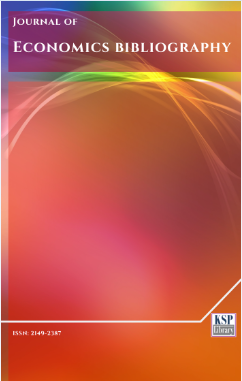Recent US-China tariff war: Opportunities for Indian pharmaceutical exports?
Abstract
Abstract. The inception of World Trade Organization (WTO) in 1995 was expected to reduce trade barriers across member countries on one hand and facilitate growth though promotion of international trade in merchandise products and services on the other. The subsequent WTO-led reforms deepened the globalization wave. In recent times however, the world is witnessing a phase of ‘de-globalization’, with rise in trade barriers and inwardness. The recent increase in US tariffs on Chinese exports and countermeasures imposed by China are a case in point. In 2014 India has initiated the Make-in-India scheme for deepening industrialization and facilitating exports. The current paper evaluates the possible opportunities for expanding Indian pharmaceutical exports in the US market, given the increase in tariff against Chinese products with the help of select trade indices. The analysis portrays a modest opportunity for Indian pharmaceutical exports in the US market, based on their past performance. Only six products at HS 6-digit level, based on the six indicators, are found to be enjoying competitiveness in the US market. The paper concludes that facilitating R&D in pharma segment as well as expanding the coverage of mutual recognition of standards in US may be explored as possible steps for enhancing Indian exports.
Keywords. India, US, Pharmaceutical trade, Trade indices, Trade policy, Make in India.
JEL. F10, F13.Keywords
References
ASSOCHAM, (2016). IPR in pharmaceuticals: Balancing, innovation and Access, [Retrieve from].
Baldwin, R. (2014). Reconciling Regionalism and Multilateralism in a Post-Bali World Multilateralising 21ST Century Regionalism, Global Forum on Trade, 11-12 February, OECD Conference Centre, Paris.
Baldwin, R., & Evenett, S. (2009). The Collapse of Global Trade, Murky Protectionism, and the Crisis: Recommendations for the G20, London: Centre for Economic Policy Research.
Bouët, A., & Laborde, D. (2017). US Trade Wars with Emerging Countries in the 21stCentury: Make America and Its Partners Lose Again, IFPRI Discussion Paper, No.01669.
Capital Trade Incorporated (undated). An Assessment of China’s Subsidies to Strategic and Heavyweight Industries, submitted to the U.S.-China Economic and Security Review Commission, Washington DC: CTI.
Chakraborty, D. (2018). Picking the right alternative: Should India participate in TPP instead of RCEP?, in J. Chaisse, H.G. & C. Lo (eds.), The Transpacific Partnership: A Paradigm Shift in International Trade Regulation, (pp.501-519), Singapore: Springer.
Deeds, C., & Whiteford, S. (undated). The Social and Economic Costs of Trump’s Wall’, Voice of Mexico, [Retrieved from].
DW, (2018), ‘China retaliates after US imposes new $200 billion tariffs’, [Retrieved from].
Economic Times, (2016). In 6 years, US FDA rejected 13,000 Indian products, February 9, New Delhi.
Federation of Indian Chambers of Commerce & Industry, (2015). Realising “Make in India”–Journey to become the most preferred manufacturer of high quality affordable medicines, [Retrieved from].
Fergusson, I.F. (2011). World Trade Organization Negotiations: The Doha Development Agenda, Washington DC: Congressional Research Service. No. RL32060.
Government of India, (2018). Progress Under 'Make in India' Programme’, Unstarred Question, Rajya Sabha, No.1631. [Retrieve from].
Government of India, (2017). Public Procurement (Preference to make in India) Order 2017, [Retrieved from].
Government of India (2015). India’s Foreign Trade Policy 2015-2020, [Retrieved from].
Government of India, (2011a). National Manufacturing Policy, New Delhi: Department of Industrial Policy and Promotion, Ministry of Commerce and Industry.
Government of India (2011b), ‘Boosting India’s Manufacturing Exports’, Report of the Working Group to Planning Commission, New Delhi: Department of Commerce, Ministry of Commerce and Industry.
Government of India (undated), ‘Make-in-India’, [Retrieved from].
Helble, M. (2017). Salvaging the trans-pacific partnership: Building blocks for regional and multilateral trade opening?’, ADBI Working Paper Series, No.695.
Horn, H., Mavroidis, P.C., & Sapir, A. (2009). Beyond the WTO? An anatomy of EU and US preferential trade agreements’, Bruegel Blueprint Series, Volume VII, Brussels: Bruegel.
India Brand Equity Foundation, (2018). Indian Pharmaceuticals Industry Analysis, [Retrieved from].
India Brand Equity Foundation, (2015). Pharmaceuticals, [Retrieved from].
International Federation of Pharmaceutical Manufacturers & Associations, (2017). The Pharmaceutical Industry and Global Health: Facts andFigures 2017, [Retrieved from].
International Monetary Fund, (2018). World Economic Outlook 2018: Cyclical Upswing, Structural Change, Washington DC: IMF.
International Trade Centre. (undated). Trade Map. [Retrieved from].
James, H. (2017). Deglobalization as a Global Challenge, CIGI Papers, No.135.
Joseph, R.K. (2011). The R&D Scenario in Indian Pharmaceutical Industry, RIS Discussion Paper, No.176.
Kallummal, M., & Bugalya, K. (2012). Trends in India’s Trade in Pharmaceutical Sector: Some Insights’, [Retrieved from].
Lim, L. (2018). Trump’s Protectionism: Method to the Madness?’, RSIS Commentary, No.47.
Lincicome, S. (2017). Doomed to Repeat It: The Long History of America’s Protectionist Failures, Cato Policy Analysis, No.819.
Neufeld, N. (2014). Trade Facilitation Provisions in Regional Trade Agreements: Traits and Trends, ERSD Staff Working Paper, No.2014/01.
Phadnis, A. (2017). Another US warning on Indian drugs’, February 25, Mumbai: Business Standard.
Pricewaterhouse Coopers, (2010). Global pharma looks to India: Prospects for growth, London: PWC.
Shepherd, B. (2016). Trade Facilitation and Global Value Chains: Opportunities for Sustainable Development, Geneva: International Centre for Trade and Sustainable Development (ICTSD).
Stiglitz, J.E. (1987). The causes and consequences of the dependence of quality on price,Journal of Economic Literature, 25(1), 1-48.
United States Trade Representative, (2018). Notice of Determinationand Request for Public Comment Concerning Proposed Determination of Action Pursuant to Section 301: China’s Acts, Policies, and Practices Related to Technology Transfer, Intellectual Property, and Innovation’, Docket No. USTR-2018-0005. [Retrieved from].
DOI: http://dx.doi.org/10.1453/jeb.v5i4.1778
Refbacks
- There are currently no refbacks.
.......................................................................................................................................................................................................................................................................................................................................
Journal of Economics Bibliography - J. Econ. Bib. - JEB - www.kspjournals.org
ISSN: 2149-2387.
Editor: [email protected] Secretarial: [email protected] Istanbul - Turkey.
Copyright © KSP Library

